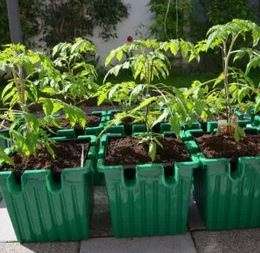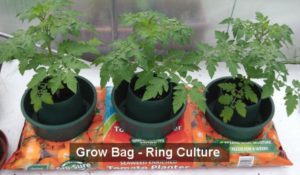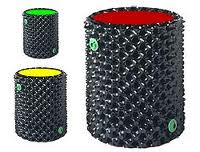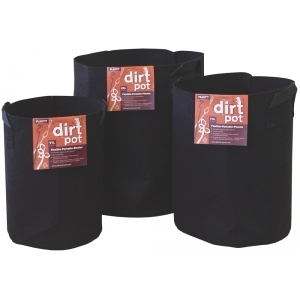Growing tomatoes in containers is probably the most popular way to grow tomatoes in the UK and in many other countries too!
Upside-down planters, large pots and window-boxes, containers are so convenient when it comes to growing tomatoes.

Grow bags are containers too and can be filled with any growing medium – soil mixed with perlite is particularly effective.
Choosing a tall pot or hanging basket for a trailing variety or a grow bag for a tall indeterminate plant works well. Whatever the job, containers have it covered!
Some of the benefits of containers include:
- Can be placed anywhere in the garden, patio or balcony.
- Grow bag soil and potting compost is free from disease.
- Plants can be moved into the sun, shade or undercover depending on weather conditions.
- Most tomato varieties are suitable for container growing – from a trailing variety in a hanging basket to an indeterminate variety in a grow bag.

Types of Containers include:
Large plastic or terracotta pots – a good way to grow tomatoes – plastic pots are inexpensive.
Air pots – produces very good results by allowing more air into the root zone.
Fabric pots – allows air into the root zone and easy to water in trays.
Grow bags – a container that comes with its own soil and inexpensive.
Grow rings – ring culture normally used with grow bags and improves feeding and watering.
Grow bags cut in half and stood on ends – two heavy duty plastic bags with soil in.
Hanging baskets – best for trailing varieties.
Upside down planters – can be effective but be aware of weight.

Air pots (right) enable oxygen to enter into the root zone more easily through the many holes in their side.
Soil – Growing Medium – Substrate
The variety of potting composts at the garden centre seems to increase each season and so does the price!
The most important attributes for soil in a container growing are:
- Holds moisture well
- Holds air and doesn’t compact when it begins to dry
- Is disease-free
The air and moisture holding qualities can be easily improved by adding perlite or vermiculite.
The Pros and Cons of Weight
A John Innes mix is excellent for containers because of the quality of the ingredients and the weight adds stability.
Compost for hanging baskets, where weight is an issue, a mix of mutli-purpose and John Innes with added perlite is excellent.
It’s best to add your own perlite – anywhere from 10% and up to 50% of the potting compost/perlite ratio – the more you add, the better the roots will like it!
I should mention that a multi-purpose compost that is high in peat, is undesirable because peat shrinks as it dries and air is removed from around the roots – not good for small containers!
The introduction of air pots and fabric pots provide an important benefit in tomato growing:
Roots need air!
More precisely, roots need oxygen and without it, plants won’t grow. It is estimated that tomato plants absorb 98% of the oxygen they need through their roots.
Root Capping
The surface area of a container is usually a lot less than roots require, so the fine surface roots will grow ’round and ’round at the soil surface forming a tight cap. This prevents air from entering the root zone and often retards plants by starving them of oxygen.

Dirt pots are one of the many brands of fabric pot and allow air to be absorbed into the roots more easily.
Oxygen starved root zones also reduce the uptake of some nutrients – iron for example. Iron deficiency in container grown tomatoes is very common.
More details about container optimization and tips here:
Tips for Growing Tomatoes in Pots & Containers
Grow Bag Pots and Ring Culture

